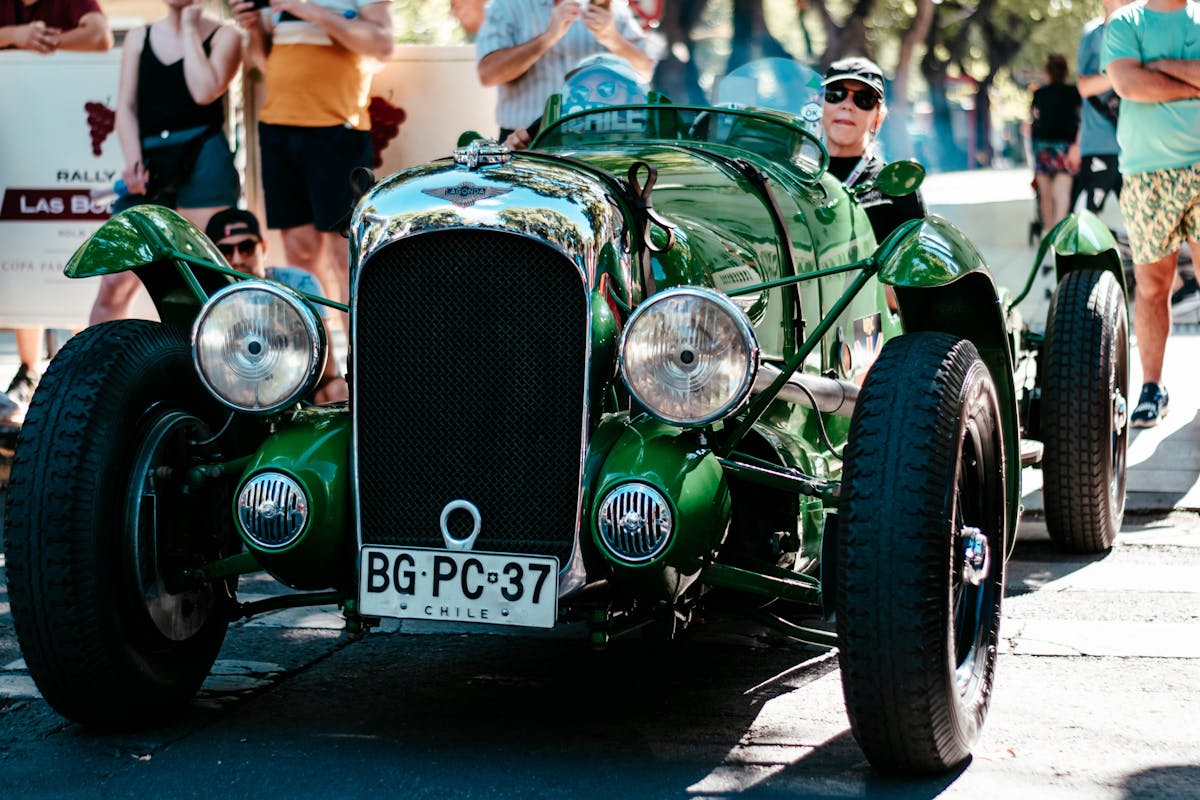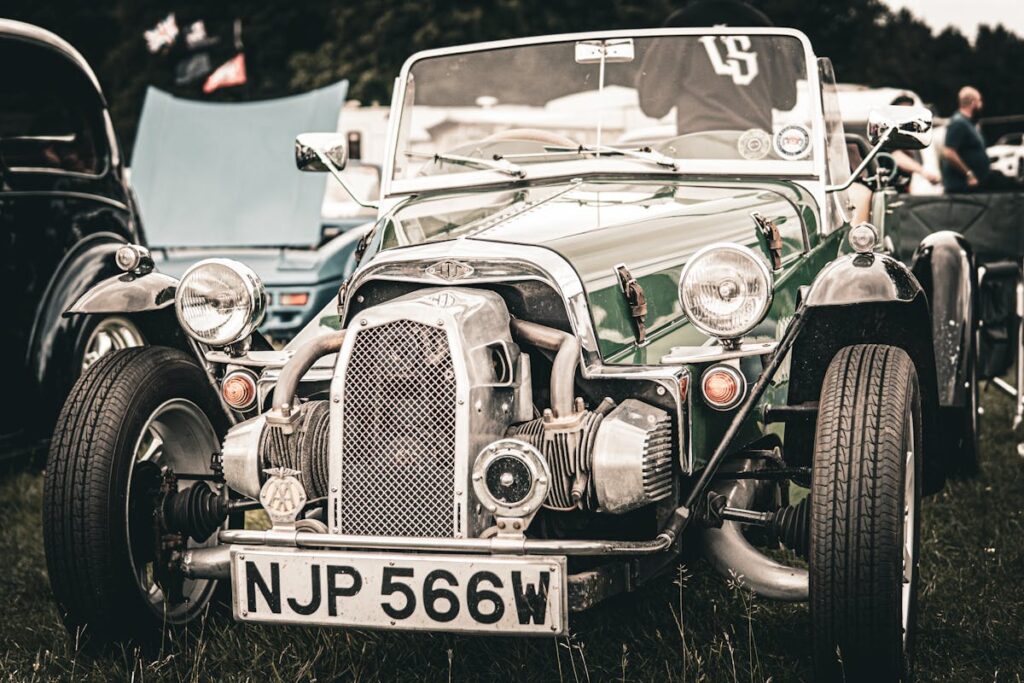While classic cars are a reflection of automotive history, they demand a unique and dedicated maintenance approach to preserve their legacy. Regular check-ups, appropriate cleaning methods, and utilizing the correct oil type are just the tip of the iceberg. In addition, the role of climate-controlled storage and rust management can’t be overlooked in protecting these vintage beauties from environmental harm. Let’s unfold these layers of classic car care and maintenance in detail, to help guarantee that your prized possession continues to be a shining representation of the golden era of automobiles.
Understanding Classic Car Anatomy
To truly appreciate the charm of a classic car, one must explore beneath its polished exterior and understand its unique anatomy. The heart of this marvelous machine, the engine, is made up of a myriad of components, each playing a vital role in delivering the nostalgic performance associated with classic cars.
Engine components such as the crankshaft, pistons, and valves are responsible for converting fuel into power, a complex ballet of perfect timing and precision. The carburetor, a component seldom found in modern vehicles, is responsible for mixing air and fuel in the perfect ratio for combustion, the lifeblood of these automotive beauties.
Equally important are the electrical systems. They control everything from the ignition, starting the engine with a turn of a key, to the lights, indicators and wipers, ensuring safe operation in all conditions. The dynamo, a precursor to today’s alternator, generates the power necessary for all these systems to function.
Understanding these elements and their interplay is the first step into the enchanting world of classic car maintenance and preservation. It’s a journey that demands passion, knowledge, and respect for the engineering marvels of yesteryears.
Routine Inspection and Servicing
Understanding the inner workings of a classic car sets the foundation for its preservation. With this knowledge, you can effectively perform routine inspections and servicing, essential to maintaining the car’s performance and aesthetic appeal. This process involves diligent observation, precise measurement, and keen understanding of the car’s needs.
Regularly checking fluid levels is a fundamental part of any inspection. Engine oil, coolant, brake fluid, transmission fluid, and power steering fluid are all critical for the car’s smooth operation. Just like the human body needs blood to function efficiently, a car requires these fluids to perform at its best. Neglecting fluid levels can lead to severe damage, resulting in costly repairs or irreversible damage.
A thorough brake inspection should also be part of your routine maintenance. This includes examining the brake pads, rotors, and lines for signs of wear or damage. Keep in mind that safety should never be compromised. A fault in the brake system could lead to a catastrophic failure, endangering lives.
Proper Cleaning Techniques
Maintaining the aesthetic appeal of your classic car requires more than just routine inspections and servicing; it calls for diligent cleaning with an understanding of proper techniques. The choice of cleaning products is crucial, as incorrect choices can adversely affect the car’s original finish and detailing. In addition, employing effective washing procedures guarantees that each cleaning session extends the life and enhances the beauty of your vintage gem.
Choosing Right Cleaning Products
In the domain of classic car maintenance, the selection of appropriate cleaning products is paramount. The right products not only guarantee thorough cleaning, but also protect the car’s surface, promoting its longevity and preserving its classic charm.
When selecting cleaning products, product safety should be your top priority. Opt for non-abrasive, pH-balanced products that are designed specifically for automobiles. Eco-friendly options are highly recommended as they are not only safe for your classic car, but also for the environment.
Detailing kits, which usually include a range of products for different parts of the car, can be a cost-effective and convenient choice. However, verify that each product in the kit is compatible with your car’s surface materials.
While there are many brands available in the market, some stand out due to their proven track record in classic car maintenance. Brands like Meguiar’s, Chemical Guys, and Mother’s are often recommended by experts for their quality and reliability.
Cost considerations are important too. While you should not compromise on quality, look for competitively priced products that offer good value for money.
Effective Washing Procedures
Having selected the appropriate cleaning products for your classic car, the next step is to understand how to use them effectively. It begins with pre-wash preparation, vital to protect your vehicle’s surface from scratches. This involves the removal of any loose dirt or debris.
Pressure washing can be beneficial, but it is important to use the correct pressure to avoid damaging the paintwork. Always be mindful of detailing considerations such as crevices and chrome details, which require gentle handling and specific cleaning tools.
Drying techniques play a significant role in maintaining your car’s shine and preventing water spot formation. Using microfiber towels for drying not only absorbs water effectively but also reduces the risk of scratches.
Seasonal washing is also fundamental. In summer, wash your car in the evening to avoid quick drying that can lead to water spots. In winter, washing can help remove road salt that can cause rust.

Importance of Regular Oil Changes
The lifeblood of your classic car’s engine is its oil, playing a pivotal role in its health and longevity. Regular oil changes can bring significant benefits, including improved performance, reduced wear and tear, and enhanced fuel efficiency. We will now explore how to select the right oil for your classic car and provide a guide on the frequency of oil changes, ensuring your vehicle remains in peak condition.
Benefits of Oil Changes
Regular oil changes serve as the lifeblood of your classic car’s engine, guaranteeing that it runs smoothly and efficiently. This seemingly simple maintenance step is essential for engine longevity, playing a significant role in sustaining your vehicle’s performance over time.
The primary benefit of oil changes is the reduction of friction within the engine. Fresh oil acts as a lubricant, reducing the wear and tear on engine components caused by metal-on-metal contact. This in turn leads to a longer-lasting engine, preserving the value and functionality of your classic car.
Oil viscosity, or the thickness and flow rate of oil, is another important aspect to take into account. Over time, oil loses its viscosity due to extreme heat and pressure conditions in the engine. This loss of viscosity can lead to increased friction, resulting in accelerated engine wear and potential damage. Regular oil changes guarantee that the oil retains its ideal viscosity, providing maximum engine protection.
Selecting the Right Oil
Understanding the importance of oil changes, one might wonder what type of oil is best suited for their classic car. The right choice of oil can greatly impact the vehicle’s performance and longevity. To make the best decision, it is vital to understand two key elements: oil viscosity and synthetic options.
Oil viscosity refers to the oil’s resistance to flow. Classic cars often require more viscous (thicker) oils than modern vehicles. This is because their engine components have wider clearances that need heavier oils to maintain adequate lubrication.
Synthetic options, on the other hand, are a modern innovation. They offer superior performance and protection compared to conventional oils, but they may not always be the best choice for classic cars. This is due to their potential to cause leaks in older seals not designed for such oils.
To guarantee ideal care for your classic car, consider these factors:
- Match the oil viscosity to your car’s specific needs.
- Understand the pros and cons of synthetic options.
- Consult with a car maintenance professional or other classic car enthusiasts for personalized advice.
Oil Change Frequency Guide
A well-maintained classic car is the epitome of automotive elegance, but to achieve such a status, one must adhere to a rigorous oil change schedule. This is not merely a matter of preserving the vehicle’s aesthetic appeal, but it is also central to its performance and longevity. The frequency of oil changes depends on several factors, including the type of oil used, the condition of the oil filter, and the vehicle’s operating conditions.
The oil filter plays a critical role in this process. As oil circulates through the engine, the filter traps contaminants that could otherwise harm internal components. Over time, however, the filter becomes clogged and less effective, necessitating replacement. Concurrently with the oil change, the filter should be changed to guarantee the fresh oil remains clean and efficient.
Oil additives can also impact the frequency of oil changes. These substances, mixed into the oil, can enhance performance and protect the engine. Some additives can even extend the life of the oil, potentially reducing the need for frequent changes. However, their use should be tailored to the specific needs and condition of the car’s engine. Regular oil changes and attentive maintenance are key to preserving the grace and performance of a classic car.
Climate Control and Storage
Proper climate control and strategic storage are key in preserving the integrity of a classic car. Temperature regulation and humidity control are critical factors to evaluate, as both can heavily impact a car’s condition over time.
Temperature regulation is necessary to prevent damage to the car’s engine, paintwork, and interior. This means storing your car in a place where the temperature doesn’t fluctuate drastically. A climate-controlled garage is ideal, but if not possible, a well-insulated garage with a stable temperature should suffice.
Humidity control is equally important. High humidity can lead to rust, while low humidity can dry out leather interiors and cause cracking. A humidity level around 50% is generally regarded as best.
Strategic storage involves more than just a good location. It also includes proper preparation of the car before storage.
Here are some key storage tips: – Always clean your car thoroughly before storing to prevent dirt and contaminants from damaging the paintwork. – Use a breathable car cover to protect it from dust and moisture. – Keep the car off its tires if it’s going to be stored for a long time to prevent flat spots.
Tire Maintenance and Care
Undeniably, an essential aspect of classic car maintenance revolves around tire care. Classic cars often come fitted with vintage tires, which require a meticulous approach to maintenance for optimal performance and longevity.
Firstly, tire pressure plays a pivotal role in how a car handles and rides, affecting comfort, fuel efficiency, and safety. Regularly checking tire pressure and adjusting it according to manufacturer specifications is critical. The tread depth is another significant factor, guaranteeing adequate road grip and water dispersion. A worn-out tread not only compromises safety but also detracts from the car’s vintage appeal.
Tire rotation and wheel alignment are preventative measures that lengthen the life of your tires and maintain a smooth, effortless ride. Tire rotation aids in equalizing wear, while proper wheel alignment prevents uneven tire wear and guarantees straight tracking.
Seasonal changes can greatly impact tire condition. During cold winter months, tires can harden and crack, so consider tire storage solutions or switch to winter tires if necessary. Finally, your driving habits can affect tire longevity. Smooth, careful driving helps preserve vintage tires and accentuates the classic driving experience.
Upholstery and Interior Preservation
Shifting our attention to the inside of your classic car, the preservation of the upholstery and interior holds equal importance. The interior of a vintage car is an embodiment of the era it belongs to, and its upholstery materials, composed mainly of fabrics and leathers, require dedicated care.
The careful selection of interior accessories is essential in maintaining the originality while ensuring the preservation of the interior. This includes steering wheel covers, seat covers, and floor mats that are color matched and appropriate to the aesthetic of your classic car.
Moreover, restoration techniques for preserving the upholstery are diverse and extensive. They range from protective coatings, fabric treatments, to fading prevention methods. Here are three key methods:
- Applying protective coatings on leather seats to protect against UV damage and fading.
- Utilizing fabric treatments on the upholstery to resist stains and spills.
- Regularly cleaning and conditioning to prevent the accumulation of dirt, which can wear down the upholstery material over time.
Dealing With Rust and Corrosion
Battling the persistent adversary of rust and corrosion is a significant aspect of classic car maintenance. These insidious foes can rapidly devalue your prized vehicle and compromise its structural integrity. Employing rust prevention methods and ensuring corrosion protection are essential in maintaining your vintage masterpiece.
Rust treatment starts with effective surface preparation. Removing any existing rust is paramount, followed by thorough cleaning of the metal surfaces. Metal sealing then provides an initial layer of defense, making it more resistant to moisture and oxygen, the two primary agents of rust.
The undercarriage of your classic car demands special attention. This hidden area is often a hotspot for rust due to road salts and moisture. Undercarriage care involves cleaning, treating any existing rust, and applying protective coatings designed to resist the elements and abrasive road debris.
Finally, paint restoration not only enhances your classic car’s aesthetic appeal, but also serves as a formidable shield against rust and corrosion. Quality paintwork, coupled with regular waxing, provides a barrier that protects the underlying metal from the environment.
In essence, a rigorous regime of rust and corrosion management can safeguard your automotive treasure for years to come.
Frequently Asked Questions
What Type of Fuel Is Best for Classic Cars?
High-octane fuel is generally recommended for classic cars due to their high-compression engines. The use of fuel additives can also help prevent internal corrosion, ensuring the longevity and peak performance of these vintage vehicles.
How Often Should I Drive My Classic Car to Maintain Its Condition?
To maintain ideal engine health, a classic car should be driven at least once every two weeks. This driving frequency helps prevent seals from drying out and keeps the engine properly lubricated and functioning.
Are There Specific Insurance Considerations for Classic Cars?
Yes, classic car insurance considerations are unique. They often require an agreed upon value policy, based on a classic car appraisal, rather than standard market value. Consult with specialized insurers for tailored coverage options.
Whats the Best Way to Restore the Original Paint on a Classic Car?
The best method to restore original paint on a classic car involves meticulous paint restoration techniques, primarily focusing on gentle cleaning, careful polishing, and waxing, effectively preserving the car’s original finish.
Can Modern Car Parts Be Used as Replacements in Classic Cars?
Yes, modern car parts can be used in classic cars, considering modern compatibility. However, it’s essential to evaluate aftermarket options carefully to guarantee they don’t compromise the vehicle’s original aesthetics and performance.

